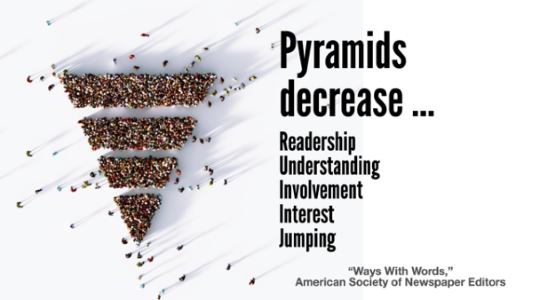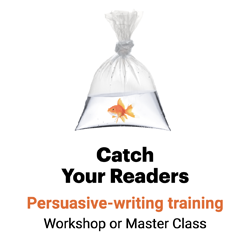Ways With Words study: Features more effective
If I told you there was a communication tool that reduces readership, diminishes understanding and causes engagement to take a nosedive, would you use it?

Friends, there is such a tool, and you are using it every day. It’s called the inverted pyramid.
That’s what researchers learned in the “Ways With Words” (PDF) study, a collaboration of the American Society of Newspaper Editors, The Poynter Institute for Media Studies, the St. Petersburg Times and the University of Wisconsin-Madison.
For the study, St. Petersburg Times beat reporters covered their regular beats, writing four versions of each story:
- Inverted pyramid, the traditional news structure
- Narrative, or storytelling with a beginning, middle and end
- Opinion piece, offering a visible point of view
- Radical clarity, where the reporter explains everything that might possibly be explained. So if you mention dog, for instance, you might add “a four-legged canine domesticated for human companionship.”
Then, in phone interviews, researchers asked subscribers:
- How much of the story they read
- Whether they followed the jump
- What they understood, using true-or-false questions
- How fair and balancedthe story was
- Whether they cared about the subject — including whether the stories connected with their own experiences and made them want to find out more or get involved
The results?
The pyramid tanks
The inverted pyramid does “not work very well with readers,” researchers concluded.

Specifically, the inverted pyramid:
- Scored lowest in readership and getting the reader across the jump. The inverted pyramid starts out boring and “gets more boring as the reader reads down,” researchers said. Who needs to stick around for the rest of that?
- Scored lowest in understanding.“Journalists put background and context in the second half of the pyramid, so the reader who does not know that background cannot understand the top of the story,” researchers said. “As a result, only journalists and sources can fully understand inverted-pyramid stories.” Is that your audience?
- Made a mediocre showing in “involvement,”or whether the story made readers connect with and want to get involved in the topic. In our business, we call involvement “engagement.” Note that engagement and the inverted pyramid are mutually exclusive.
Why are we still using this thing?
The feature structure soars
The feature, or narrative, structure, on the other hand, tended to outperform the other structures in the study. Features scored highest of all of the formats in reading and getting readers across the jump. They also made a good showing in understanding.
Instead of sticking with the inverted pyramid, a story structure that’s been proven in the lab not to work, you’d think writers would stick a fork in it, then go experiment with other story structures. But no.
“The basic conservatism and frantic pace of our profession keeps us from enlarging our repertoire of forms,” the researchers lamented. “So … we keep boring and confusing our readers, and driving them away. … We should think of the inverted pyramid as A form, rather than THE form.”
___
Source: “Ways With Words: A Research Report of the Literacy Committee,” American Society of Newspaper Editors, 1993

Leave a Reply